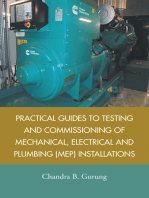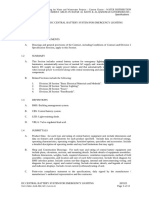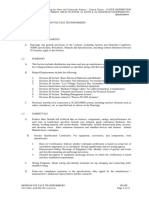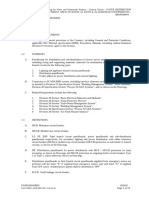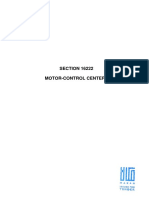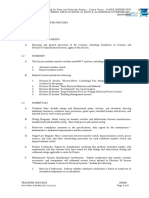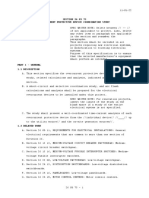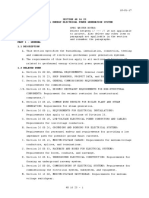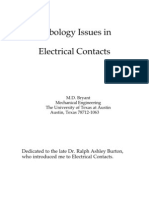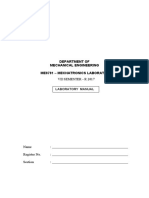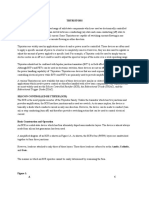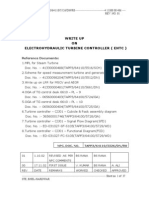SPC - 01 - Sec-263324 - DC Central Battery System For Emergency Lighting
SPC - 01 - Sec-263324 - DC Central Battery System For Emergency Lighting
Uploaded by
fouadelshabrawy71Copyright:
Available Formats
SPC - 01 - Sec-263324 - DC Central Battery System For Emergency Lighting
SPC - 01 - Sec-263324 - DC Central Battery System For Emergency Lighting
Uploaded by
fouadelshabrawy71Original Title
Copyright
Available Formats
Share this document
Did you find this document useful?
Is this content inappropriate?
Copyright:
Available Formats
SPC - 01 - Sec-263324 - DC Central Battery System For Emergency Lighting
SPC - 01 - Sec-263324 - DC Central Battery System For Emergency Lighting
Uploaded by
fouadelshabrawy71Copyright:
Available Formats
NWC Engineering & Consulting for Water and Wastewater Projects – Eastern Cluster - WATER DISTRIBUTION
NETWORK PROJECT FOR VARIOUS AREAS IN HAFAR AL BATIN & AL-QAISOMAH GOVERNORATES -
PHASE 9 - PART 2 - P408-1 Specifications
SECTION 263324 - DC CENTRAL BATTERY SYSTEM FOR EMERGENCY LIGHTING
PART 1 - GENERAL
1.1 RELATED DOCUMENTS
A. Drawings and general provisions of the Contract, including Conditions of Contract and Division 1
Specification Sections, apply to this Section.
1.2 SUMMARY
A. This Section includes central battery system for emergency lighting that monitors individual
luminaires, automatically sense loss of normal AC supply and transfer loads from normal AC to
battery DC supply on supply power failure, and that automatically retransfer to normal supply
when normal power is restored along with central monitoring and automatic testing for all system
components.
B. Related Sections include the following:
1. Division 26 Section "Basic Electrical Materials and Methods".
2. Division 26 Section “Interior Lighting”.
3. Division 26 Section “Fuses”.
4. Division 26 Section “Panelboards”.
1.3 DEFINITIONS
A. BMS: Building management system.
B. CBS: Central battery system.
C. LED: Light-emitting diode.
D. VRLA: Valve-regulated lead acid.
1.4 SUBMITTALS
A. Product Data: for each type and rating of central battery equipment unit include dimensions and
data on features and components for each product specified. Include data on electrical ratings,
operating characteristics, operating weights, furnished options, specialties and accessories. Include
a detailed description of operating modes and any load limitations that may apply.
B. Shop and Construction Drawings: For each type and rating of central battery equipment unit
include plans, elevations, sections, and mounting details. Include details of equipment assemblies.
Indicate dimensions, weights, loads, required clearances, ventilation requirements, method of field
assembly, components, and location and size of each field connection. Include block diagram for
BMS interface points. Include system one-line diagram, internal and interconnecting wiring; and
diagrams for power, signal, and control wiring. Include elevation, details, and legends of control
and indication displays. Include circuit current (withstand) rating of unit.
C. Point-wise compliance statement to the specifications, duly signed by the manufacturer /
manufacturer’s authorized representative and the contractor.
DC CENTRAL BATTERY SYSTEM FOR EMERGENCY LIGHTING 263324
NWC-P408-1-DAR-PRE-SPC-15A-EL-01 Page 1 of 12
NWC Engineering & Consulting for Water and Wastewater Projects – Eastern Cluster - WATER DISTRIBUTION
NETWORK PROJECT FOR VARIOUS AREAS IN HAFAR AL BATIN & AL-QAISOMAH GOVERNORATES -
PHASE 9 - PART 2 - P408-1 Specifications
D. Coordination Drawings: Floor plans, drawn to scale, showing dimensioned layout, required
working clearances, and required area above and around central battery equipment. Show central
battery equipment layout and relationships between electrical components and adjacent structural
and mechanical elements. Show support locations, type of support, and weight on each support.
Indicate field measurements.
E. Qualification Data: For firms and persons specified in "Quality Assurance" Article..
F. Seismic Qualification Certificates: For central battery equipment, accessories, and components,
from manufacturer.
1. Certificate of compliance.
2. Dimensioned Outline Drawings of Equipment Unit: Identify center of gravity and locate
and describe mounting and anchorage provisions.
3. Detailed description of equipment anchorage devices on which the certification is based
and their installation requirements.
G. Product Certificates: For each type of central battery equipment.
H. Sample Warranty: For special warranty.
I. Guarantee certification for 10 years battery operation as a minimum.
J. Operation and Maintenance Data: For central battery equipment to include in emergency,
operation, and maintenance manuals.
1. In addition to items specified in Division 01:
a. Manufacturer's written instructions for testing, adjusting, and reprogramming
control modules.
b. Manufacturer's written instructions for selecting and setting field-adjustable controls
and status and alarm points.
K. Source quality-control reports.
L. Field quality control report.
M. Records and Reporting: on completion of the work, drawings of the emergency escape lighting
installation shall be provided and retained on the premises. The drawings shall be made in
accordance with EN 50171 requirements. In particular, they shall identify all luminaires and the
main components, and shall be regularly updated with any subsequent changes to the system.
These drawings shall be signed by a competent person to verify that the design meets the
requirements of this standard.
N. Log Book: a log book shall be provided for the recording of routine examinations, tests, defects
and alteration. These shall be available as a hard copy automatically printed from an automatic
testing device.
1.5 EXTRA MATERIALS
A. Furnish extra materials that match products installed and that are packaged with protective
covering for storage and identified with labels describing contents. Deliver extra materials to
client stores.
1. Fuses: 25 percent of each type and rating, but no fewer than 3 of each type.
2. Cabinet Ventilation Filters where applicable: One complete set.
3. Change Over Modules: 10% percent, minimum one unit of each type.
4. Circuit Board: One spare circuit board for each critical circuit.
DC CENTRAL BATTERY SYSTEM FOR EMERGENCY LIGHTING 263324
NWC-P408-1-DAR-PRE-SPC-15A-EL-01 Page 2 of 12
NWC Engineering & Consulting for Water and Wastewater Projects – Eastern Cluster - WATER DISTRIBUTION
NETWORK PROJECT FOR VARIOUS AREAS IN HAFAR AL BATIN & AL-QAISOMAH GOVERNORATES -
PHASE 9 - PART 2 - P408-1 Specifications
1.6 QUALITY ASSURANCE
A. Manufacture’s Certification: The manufacturer shall be specialized in manufacturing of central
battery system as specified in this document. The manufacturer shall be ISO 9001 certified and
shall design to internationally accepted standard.
B. Factory Testing: Prior to shipment the manufacturer shall complete a documented test procedure
to test all functions of the central battery system and batteries (via a discharge test), when supplied
by the CBS manufacturer and guarantee compliance with the specification. The manufacturer shall
submit a copy of the test report. Tests shall comply with EN 50171 for the central battery system
and with IEC 62034 for the automatic test system.
C. Materials and Assemblies: All materials and parts comprising the CBS shall be new, of current
manufacture, and have not been in prior service, except as required during factory testing. All
active electronic devices shall be solid state and not exceed the manufacturer’s recommended
specified tolerances for temperature or current to ensure maximum reliability. All semiconductor
devices shall be sealed. The manufacturer shall conduct inspection on incoming parts, modular
assemblies, and final products. Materials and components shall be manufacturer's latest design,
and Standards used shall be approved prior to manufacture.
D. Installer Qualifications: Experienced installer who is an authorized representative of CBS
manufacturer for both installation and maintenance of system required for this Project.
E. Local Representative: Provide evidence that proposed equipment manufacturer has a locally
established and authorized organization which can be called upon for professional advice and
maintenance as may be required, and which can immediately supply spare parts to support day to
day and emergency maintenance requirements. Failure to satisfy Engineer may disqualify a
manufacturer.
F. Standards: the emergency lighting system shall comply with the following standards:
1. DIN/VDE 0108-100 “Sicherheitsbeleuchtungsanlagen”.
2. EN 50171 “Central Power Supply Systems”.
3. EN 50172 “Emergency Escape Lighting Systems”.
4. EN 50272-2 “Safety Requirements for Secondary Batteries and Battery Installations – Part
2: Stationary Batteries”.
5. IEC 62034 “Automatic Test Systems for Battery Powered Emergency Escape Lighting”.
6. IEC 60896 “Stationary Lead Acid Batteries”.
7. IEEE 485 “IEEE Recommended Practice for Sizing Lead-Acid Batteries for Stationary
Applications”.
8. IEC 61347-1 “Lamp Controlgear - Part 1: General and Safety Requirements”.
9. IEC 61347-2-11 “Lamp Controlgear - Part 2-11: Particular Requirements For
Miscellaneous Electronic Circuits Used with Luminaires”.
10. IEC 61000-6-2 “Electromagnetic compatibility (EMC) - Part 6-2: Generic standards -
Immunity for industrial environments”.
11. IEC 61000-6-3 “Electromagnetic compatibility (EMC) - Part 6-3: Generic standards -
Emission standard for residential, commercial and light-industrial environments”.
12. NFPA 101 “Life Safety Code”.
1.7 DELIVERY, STORAGE, AND HANDLING
A. Deliver equipment in fully enclosed vehicles.
B. Prior to shipping all products shall be inspected at the factory for damage.
C. Store equipment in spaces having environments controlled within manufacturers' written
instructions for ambient temperature and humidity conditions for non-operating equipment.
DC CENTRAL BATTERY SYSTEM FOR EMERGENCY LIGHTING 263324
NWC-P408-1-DAR-PRE-SPC-15A-EL-01 Page 3 of 12
NWC Engineering & Consulting for Water and Wastewater Projects – Eastern Cluster - WATER DISTRIBUTION
NETWORK PROJECT FOR VARIOUS AREAS IN HAFAR AL BATIN & AL-QAISOMAH GOVERNORATES -
PHASE 9 - PART 2 - P408-1 Specifications
D. Equipment containing batteries shall not be stored for a period exceeding 3 months without
powering up the equipment for a period of 8 hours to recharge the batteries. Relevant Certificate
for the batteries production date shall be submitted to the Engineer.
1.8 WARRANTY
A. Special Warranty: Manufacturer agrees to repair or replace central battery system and replace
batteries that fail in materials or workmanship within specified warranty period.
1. Warranty Period: One year warranty from the date of substantial completion for central
battery system and batteries.
PART 2 - PRODUCTS
2.1 PERFORMANCE REQUIREMENTS
A. Seismic Performance: Central battery equipment shall withstand the effects of earthquake motions
determined according to ASCE/SEI 7. The designated central battery equipment shall be tested
and certified as meeting ICC-ES AC 156 test procedure requirements.
1. The term "withstand" means "the unit will remain in place without separation of any parts
from the device when subjected to the seismic forces specified and the unit will be fully
operational after the seismic event."
2.2 GENERAL REUIREMENTS
A. Emergency lighting system shall provide an average of 10.8] lux illumination level with a
maximum to minimum illumination uniformity of 40:1, throughout the facility unless otherwise
required by the local codes, whichever is more stringent.
B. Emergency lighting system shall operate for [1.5 hour(s) duration with a maximum illumination
decline to 60%
C. Emergency lighting system shall be able to control each individual fixture’s switching mode as
maintained, non-maintained or switched maintained modes connected to the same circuit without
additional dataline.
D. The battery and system design shall be capable of meeting the declared performance initially,
during and at the end of the stated life.
E. In general, emergency lighting shall be provided by using lamps from the luminaires used for the
main normal illumination, unless otherwise shown on drawings.
F. BMS Interface: CBS shall interface to the Management Level Network through a BACnet/IP to
third party gateway. The gateway shall be provided by the CBS supplier and shall be connected
into the Management Level Network by the BMS contractor. The BMS contractor shall obtain a
list of the BACnet object IDs/names from the CBS supplier.
2.3 SYSTEM OPERATION
A. Under normal conditions the load shall be fed from the normal AC power supply through the
change-over switch and the battery is re-charged up to full charge state via the battery charger.
The battery is maintained in an idle condition ready to feed the load, with continuous monitoring
of its output for healthy conditions with an alarm to be initiated in case of malfunction.
DC CENTRAL BATTERY SYSTEM FOR EMERGENCY LIGHTING 263324
NWC-P408-1-DAR-PRE-SPC-15A-EL-01 Page 4 of 12
NWC Engineering & Consulting for Water and Wastewater Projects – Eastern Cluster - WATER DISTRIBUTION
NETWORK PROJECT FOR VARIOUS AREAS IN HAFAR AL BATIN & AL-QAISOMAH GOVERNORATES -
PHASE 9 - PART 2 - P408-1 Specifications
B. Upon loss of normal power supply, the load shall be automatically transferred to DC battery
supply through the change-over switch and power shall be supplied from the batteries until the
normal supply returns, upon normal power supply restoration then the load is retransferred to the
normal supply.
C. If the normal power supply failure period exceeds the rated duration of the battery, the load shall
be automatically shut down to protect the battery from deep discharge. The system shall
automatically reset itself upon normal power supply return.
2.4 MECHANICAL CONSTRUCTION
A. The battery housing shall be sheet steel, powder coated housing IP 21 with removable screwed
front, rear and top doors to provide complete access to the batteries. The electronics section shall
have IP 21 sheet steel enclosure with transparent polycarbonate window for all central systems
and IP 21 sheet steel enclosure with full metal door for all substations. Doors and removable
panels shall be so fastened that access to dangerous live parts is not possible without the use of a
tool or key. Wireways shall be smooth and free from sharp edges, burrs, flashes, etc. which might
cause damage to the insulation of the wiring parts. Metal screws shall not protrude into wireways.
B. The enclosures shall be resistant to heat and fire and tested in accordance with EN 50171
requirements.
C. The electronic compartment shall have large cabling compartments with cable entries from top via
multiple undrilled removable metal flange plates. All incoming cables and looping circuits shall
be connected on protected and fused terminals. All outgoing luminaire circuits shall be connected
direct to relevant components via plug-in type terminals not less than 2.5 sq.m.
2.5 ELECTRICAL CONSTRUCTION
A. The system shall be built-up in a modular with all modules being plug-in-type design. The
outgoing circuits shall be fed through changeover modules. 1 module shall be used for circuits
with maximum load of 6 Amps as per DIN/VDE 0108. Each circuit shall be protected within the
system on mains and battery side via screw-in type cartridge fuses on each module. The fuses
shall be accessible via front plate of the module. The mains supply and battery mains cable shall
be protected by knife edge fuses. The fuse holders shall have handles for simple removal of the
fuses, 25 percent spare capacity shall be available in terms of circuits and modules.
B. The main panel incoming shall be switch disconnector provided with current limiting HRC fuse
type, complying with IEC 60269-2, with rated breaking capacity 120kA and manufactured by an
approved firm.
C. Each panel shall have a spare fuse carrier with at least 3 fuses for each size used in respective
panel.
2.6 CONTROL MODULE
A. The control module shall be composed of a microprocessor control module with plain text 4 line
displays with a minimum of 20 characters per line, to provide operative status and luminaire
failures.
B. The central battery equipment shall include facilities for monitoring the system function. The
following shall be measured:
1. Battery voltage.
2. Battery/charger/discharge current.
DC CENTRAL BATTERY SYSTEM FOR EMERGENCY LIGHTING 263324
NWC-P408-1-DAR-PRE-SPC-15A-EL-01 Page 5 of 12
NWC Engineering & Consulting for Water and Wastewater Projects – Eastern Cluster - WATER DISTRIBUTION
NETWORK PROJECT FOR VARIOUS AREAS IN HAFAR AL BATIN & AL-QAISOMAH GOVERNORATES -
PHASE 9 - PART 2 - P408-1 Specifications
C. The following test and monitoring equipment shall be provided:
1. Devices with automatic reset e.g. push button, to simulate a normal supply failure.
2. Isolating devices to isolate the AC supply for checking the duration of the system.
3. Indication of the actual power supply source (normal supply or battery).
4. Indication of the following faults and system condition:
a. Float charge voltage out of the permissible range.
b. Interruption of the battery charging circuit.
c. Failure in charge equipment; no charge current, although normal supply is available.
d. Supply from the battery, although normal supply is available.
e. Warning to be given at least 10 min before deep discharge protection is initiated.
f. Deep discharge protection initiated.
g. Failure of a powered ventilation system for battery cabinet or battery option.
D. LEDs shall indicate as a minimum:
1. Mains operation.
2. Battery operation.
3. Fault.
4. Deep discharge.
E. Potential free indicator contacts shall be provided for:
1. Operation.
2. Battery operation.
3. Summary fault.
F. Centronic interface for the connection of standard printers shall be provided on the front of the
control module. An electronically controlled 24 V output for the voltage monitoring of lighting
sub distribution panels shall be provided.
G. Electronically isolated mains monitoring shall be provided for maintained and non maintained
light circuits, with forced changeover in case of mains failure from mains to emergency light
operation. As a standard following programming modes shall be available.
1. Manual reset.
2. Time delay of mains return.
3. Stair well light timer adjustable from 1 to 15 minutes, where shown on Drawings.
4. Acoustic alarm in case of mains failure, manual reset or summation.
H. Individual changeover shall be provided per emergency circuit with free programming for
maintained, non-maintained or switched maintained light and 2 pole fusing conforming to VDE.
I. Failure recognition for each individual safety/exit luminaire in conjunction with proprietary
electronic ballasts including 2 wire monitoring module without additional data line.
2.7 CHANGEOVER MODULE
A. Each changeover module shall be freely programmable to suit type of luminaires connected on
outgoing circuits and switching mode of each individual luminaire i.e. maintained, non-maintained
or switch maintained. The individual luminaires monitoring circuits shall be included in the
changeover module. Each circuit in the changeover module shall have LED indications for circuit
on and lamp failure and shall be fit to monitor 20 luminaires as a minimum. All outgoing circuit
terminals shall be provided to monitor the sub distribution boards. As an alternative, modules
constructed using printed circuit may be provided.
DC CENTRAL BATTERY SYSTEM FOR EMERGENCY LIGHTING 263324
NWC-P408-1-DAR-PRE-SPC-15A-EL-01 Page 6 of 12
NWC Engineering & Consulting for Water and Wastewater Projects – Eastern Cluster - WATER DISTRIBUTION
NETWORK PROJECT FOR VARIOUS AREAS IN HAFAR AL BATIN & AL-QAISOMAH GOVERNORATES -
PHASE 9 - PART 2 - P408-1 Specifications
2.8 MONITORING / ADDRESS MODULE
A. Monitoring module shall be provided for luminaire with standard electronic ballast and connected
to the central battery system. Monitoring module shall be compatible with electronic ballasts from
any manufacturer with the following features: it must be able to operate with both AC and DC
voltage, it must shut itself off in an event of a lamp failure, input current in shut off mode must be
less than 10mA and must have constant power output high frequency electronic control gear /
transformer. The electronic ballast shall be “CE” marked and shall comply with IEC 60929.
B. Monitoring / address modules shall comply with IEC 61347-1 and IEC 61347-2-11.
C. Monitoring modules shall be able to accept 230V AC at 60 Hz and 220 V +25/-20 % DC.
Monitoring / address modules shall be protected against reverse polarity. Monitoring / address
module shall have IP 20 degree of protection to IEC 60529 and a flame retardant housing.
D. Monitoring / address modules shall have selector switches for 20 addresses as a minimum and
shall have a 230V AC control input connected to the branch circuit from a node after the switch in
case of switched maintained fixtures. Fixtures fed from two sources where shown on drawings
such as a dimmed general lighting or switched maintained circuits shall be provided with
monitoring module with an integrated changeover or a separate switch controller such that in case
of battery operation either in mains failure or testing the fixture is fed from the battery source.
Emergency fixtures controlled through DALI protocol shall be provided with monitoring module
with DALI control input.
2.9 ELECTRONIC ADDRESSABLE BALLASTS AND LED CONTROL GEARS FOR EXIT
SIGNS
A. Safety and exit luminaires shall be provided with high frequency electronic addressable ballast
without monitoring module or LED electronic gear in case of LED luminaires, with 20 addresses
as a minimum for function monitoring in DC-operation without additional data line and free
programmable switching mode as maintained, non-maintained or switched maintained luminaires
in one circuit without additional data line. Ballasts shall able to operate with both AC and DC
voltage and shall have automatic lamp detection including automatic switch-off in the event of a
lamp defect and automatic restart after lamp replacement.
B. Electronic addressable ballast shall comply with IEC 60929, IEC 61347-2-3 and IEC 61347-2-4.
Electronic LED control gear shall comply with IEC 61347-2-13 and IEC 62384
C. Electronic addressable ballast and LED control gear shall meet the limits of main harmonic
content as defined in IEC 61000-3-2 and comply with radio interference suppression limits
defined in BS EN 55015 and immunity requirements of IEC 61547. Ballasts shall have Efficiency
Index EEI=A2, power factor corrected to above 0.9. The electronic ballast shall be “CE” marked
and shall comply with IEC 60929. All electronic addressable ballasts and LED control gear for the
exit luminaires shall be manufactured by the emergency central battery system manufacturer.
D. LED electronic control gear shall be high efficiency, high power factor, suitable for operation at
the ambient conditions specified for the project. Control gear shall have constant output current or
constant output voltage over the whole wattage range independent of mains supply fluctuations as
shown on drawings and sufficient for operating the number and wattage of LEDs connected.
E. Control gear shall have electrical insulation between primary and secondary sides. Maximum
length between control gear and LED module shall be as per manufacturer’s recommendations.
F. Electronic addressable ballasts and LED control gear shall be able to accept 230V AC at 60 Hz
and 220 V +25/-20 % DC. Ballasts shall be protected against reverse polarity. Ballasts shall have
IP 20 degree of protection to IEC 60529 and a flame retardant housing.
G. Whenever the main lighting fixtures are used as emergency lighting or exit signs are obtained
from manufacturer different than that of the CBS, the Contractor shall ensure coordination
DC CENTRAL BATTERY SYSTEM FOR EMERGENCY LIGHTING 263324
NWC-P408-1-DAR-PRE-SPC-15A-EL-01 Page 7 of 12
NWC Engineering & Consulting for Water and Wastewater Projects – Eastern Cluster - WATER DISTRIBUTION
NETWORK PROJECT FOR VARIOUS AREAS IN HAFAR AL BATIN & AL-QAISOMAH GOVERNORATES -
PHASE 9 - PART 2 - P408-1 Specifications
between both manufacturers. Central battery supplier shall provide necessary addressable modules
for each fixture.
2.10 LOCAL CONTROLLER / BRANCH CIRCUITS MONITORING MODULE
A. Final branch lighting circuits feeding non maintained or switched maintained emergency fixtures
shall be monitored for operation through single or 3 phase voltage monitor, as the case may be,
installed in the lighting sub-distribution boards or a single phase control relay shall be installed in
final circuit when required. The non-maintained and switched maintained luminaires shall be lit
during a local supply failure. However the emergency supply panel shall not switch to battery use
as long as its own mains supply is available. The Local Controllers should comply with IEC
61347-1 and IEC 61347-2-11.
2.11 CHARGER
A. Charger module shall be micro processor controlled module with temperature controlled voltage
charging to IU characteristics. Automatic boost charging facility shall be built in to the system
depending on the required total battery capacity. It shall have charging and supervising method
for failure indication of battery circuits as well as battery charger. Battery chargers shall be
capable of automatically charging their batteries that have been discharged so that they can
perform at least 80 % of their specified duration within 12 h of commencement of charge in
accordance with EN 50171. The charger shall have built in deep discharge protection and shall be
provided with LED indications for:
1. Operation.
2. Charger on.
3. Booster on.
4. Mains operation.
5. Battery capacity >10 percent, >50 percent, 100 percent.
6. Charging failure.
7. Insulation fault.
B. Charger shall have potential free indicator contacts for:
1. Charging failure.
2. Fast charge.
3. Insulation fault.
C. The battery charger shall be so designed that a short circuit on its output will not cause damage.
D. Charger shall have a push button to simulate earth leakage failures. Charger shall include plug-in-
type terminals as well as the protection fuses for mains and battery accessible via the front plate of
the charger.
2.12 BATTERIES
A. Batteries shall be maintenance free, VRLA sealed leak proof 230 V and in compliance with IEC
60896. Batteries shall have extremely low gas generation, low self discharge and have
permanently sealed pressure release vents.
DC CENTRAL BATTERY SYSTEM FOR EMERGENCY LIGHTING 263324
NWC-P408-1-DAR-PRE-SPC-15A-EL-01 Page 8 of 12
NWC Engineering & Consulting for Water and Wastewater Projects – Eastern Cluster - WATER DISTRIBUTION
NETWORK PROJECT FOR VARIOUS AREAS IN HAFAR AL BATIN & AL-QAISOMAH GOVERNORATES -
PHASE 9 - PART 2 - P408-1 Specifications
B. Battery ampere-hour rating shall be sufficient for emergency period specified with all luminaires
operating at full luminous output, to a discharge limit of not less than 1.75 V per cell. Cells shall
be normally maintained at 2.25 V per cell. Guaranteed life shall not be less than 10 years, with a
capacity drop down to not less than 80% under normal expected service. At the end of the
specified duration for the system, the output voltage shall be not less than 90% of the nominal
voltage at the nominal load. Battery strings shall consist of 18 blocks of 12 V batteries. Batteries
shall consist of one string for ratings up to 10 kVA and of two strings for rating above 10 kVA.
C. Batteries shall be installed and provision for maintenance made in accordance with EN 50272-2
and manufacturer’s recommendations.
D. Date of manufacture shall be stamped on each battery and shall be less than 3 months from the
date of delivery to the site.
E. Battery calculations according to IEEE 485 shall be carried out by the CBS supplier and submitted
for approval, based on the following:
1. Nominal active power factor of not less than 0.9 Lag
2. Temperature factor for operation at 25 Deg C.
3. Aging factor of 1.25.
4. Design margin factor of 1.15.
5. Recharge time not exceeding 12 hours so that the battery can perform at least 80 % of their
specified duration.
2.13 CENTRAL MONITORING DEVICE
A. The central monitoring shall be via central group monitoring hardware and software, monitoring
and programming unit. The unit shall operate with latest visualization software to give detailed
text, address and information of all luminaires connected to system. It shall have
programming/automatic testing facility for time duration test, function test, location of luminaire,
manual rest and acoustic alarm. It shall have facility for software interface to the BMS to provide
transmission of all data records as desired.
2.14 AUTOMATIC AND CYCLIC FUNCTION MONITORING AND LOGGING FACILITY
A. Automatic test system shall comply with IEC 62034.
B. An automatic test unit with a recording facility shall be installed with the following features as a
minimum:
1. Constant monitoring of the charge, the intervals shall be less than 5 minutes where
monitoring is periodic.
2. Cyclical monitoring of switching and functional capacity of the connected load for the
emergency power supply. Test shall be carried at least once every week with a test duration
between 10 seconds and 5 minutes provided that the total is less than 10 minutes per week.
3. Recording of any faults in the central power supply system and any fault in the test
equipment or central monitoring.
4. Fault notification where there is a fault in the transmission route to the central monitoring
point.
5. A facility for manual initiation of the test on the central power supply or on the central
monitoring unit.
DC CENTRAL BATTERY SYSTEM FOR EMERGENCY LIGHTING 263324
NWC-P408-1-DAR-PRE-SPC-15A-EL-01 Page 9 of 12
NWC Engineering & Consulting for Water and Wastewater Projects – Eastern Cluster - WATER DISTRIBUTION
NETWORK PROJECT FOR VARIOUS AREAS IN HAFAR AL BATIN & AL-QAISOMAH GOVERNORATES -
PHASE 9 - PART 2 - P408-1 Specifications
C. If a mains supply failure occurs up to four hours before a programmed functional test, the test shall
be postponed and rescheduled for between 4 h and 24 h after restoration of the mains supply. In
the event that a functional test is postponed, indication of the pending test shall be given on the
remote panel. If a mains supply failure occurs up to 24 h before a programmed rated duration test,
the start of the test shall be postponed and rescheduled within seven days after restoration of the
mains supply.
D. The limited duration test shall be performed for two thirds of the rated duration. The central
emergency power supply system shall be automatically checked to ensure that the battery has not
discharged to a lower voltage than is required for a discharge of two thirds of the rated duration.
2.15 WIRING
A. Internal wiring used to carry AC supply and safety equipment circuits shall be separated from each
other by running through separate compartments or by double insulation.
B. All wiring shall comply with the requirements of Division 26 Section “Low Voltage Electrical
Power Conductors and Cables”.
PART 3 - EXECUTION
3.1 EXAMINATION
A. Receive, inspect, handle, and store central battery equipment according to manufacturer’s
recommendations.
B. Examine areas, surfaces, and substrates to receive central battery equipment, with Installer present,
for compliance with requirements for installation tolerances, structural support, ventilation,
temperature, humidity and other conditions affecting performance of the Work.
1. Verify that manufacturer's written instructions for environmental conditions have been
permanently established in spaces where equipment will be installed, before installation
begins.
C. Examine equipment before installation. Reject equipment that is wet, moisture damaged, or mold
damaged.
D. Examine routing layout for electrical connections to verify actual locations of connections before
installation.
E. Proceed with installation only after unsatisfactory conditions have been corrected.
3.2 INSTALLATION
A. Clearance: According to manufacturer's written instructions, but not less than 900 mm in front of
unit.
B. Seismic Bracing: Comply with requirements specified in Division 26 Section "Vibration and
Seismic Controls for Electrical Systems."
DC CENTRAL BATTERY SYSTEM FOR EMERGENCY LIGHTING 263324
NWC-P408-1-DAR-PRE-SPC-15A-EL-01 Page 10 of 12
NWC Engineering & Consulting for Water and Wastewater Projects – Eastern Cluster - WATER DISTRIBUTION
NETWORK PROJECT FOR VARIOUS AREAS IN HAFAR AL BATIN & AL-QAISOMAH GOVERNORATES -
PHASE 9 - PART 2 - P408-1 Specifications
C. Temporary Lifting Provisions: Remove temporary lifting eyes, channels, and brackets and
temporary blocking of moving parts from enclosures and components.
D. Wiring within Enclosures: Bundle, lace, and train conductors to terminal points with no excess
and without exceeding manufacturer's limitations on bending radii. Install lacing bars and
distribution spools.
3.3 IDENTIFICATION
A. Identify equipment and components according to Division 26 Section "Basic Electrical Materials
and Methods" and shall comply with EN 50171.
3.4 FIELD QUALITY CONTROL
A. Manufacturer's Field Services: Supervision of unit installation, connections, and adjustments by a
factory-authorized service representative. Report results in writing.
B. Tests: Perform tests listed below according to manufacturer's written instructions. Test unit
functions, operations, and protective features. Adjust to ensure operation complies with
Specifications. Perform tests on completion of unit installation and after building circuits have
been energized. Provide instruments to permit accurate observation of tests. Include the
following tests:
1. Simulate Malfunctions: Verify protective device operation.
2. Demonstrate low-battery-voltage shutdowns, and transfers due to normal source failure and
restoration.
3. Verify emergency-supply duration.
4. Test for Successful Supply: Operate each type of load served by the unit for this Project
without symptoms of abnormal supply such as noise, vibration, or pulsation of the load or
its output.
C. Retest: Correct deficiencies identified by tests and observations and retest until specified
requirements are met.
3.5 CLEANING
A. On completion of installation, inspect unit components. Remove paint splatters and other spots,
dirt, and debris. Touch up scratches and abrasions in finish to match original finish. Clean unit
internally using methods and materials recommended by manufacturer.
3.6 PROTECTION
A. Temporary Heating: Apply temporary heat to maintain temperature according to manufacturer's
written instructions until controllers are ready to be energized and placed into service.
B. Replace central battery equipment whose interiors have been exposed to water or other liquids
prior to Substantial Completion.
3.7 COMMISSIONING
A. Battery Equalization: Manually equalize charging of battery cells according to manufacturer's
written instructions. Record individual cell voltages.
DC CENTRAL BATTERY SYSTEM FOR EMERGENCY LIGHTING 263324
NWC-P408-1-DAR-PRE-SPC-15A-EL-01 Page 11 of 12
NWC Engineering & Consulting for Water and Wastewater Projects – Eastern Cluster - WATER DISTRIBUTION
NETWORK PROJECT FOR VARIOUS AREAS IN HAFAR AL BATIN & AL-QAISOMAH GOVERNORATES -
PHASE 9 - PART 2 - P408-1 Specifications
3.8 DEMONSTRATION
A. Train Employer's maintenance personnel to adjust, operate, and maintain the system installation.
Refer to Division 1
END OF SECTION 263324
DC CENTRAL BATTERY SYSTEM FOR EMERGENCY LIGHTING 263324
NWC-P408-1-DAR-PRE-SPC-15A-EL-01 Page 12 of 12
You might also like
- Practical Guides to Testing and Commissioning of Mechanical, Electrical and Plumbing (Mep) InstallationsFrom EverandPractical Guides to Testing and Commissioning of Mechanical, Electrical and Plumbing (Mep) InstallationsRating: 4 out of 5 stars4/5 (4)
- SPC - 01 - Sec-263323 - DC Central Battery System For Emergency LightingDocument12 pagesSPC - 01 - Sec-263323 - DC Central Battery System For Emergency Lightingfouadelshabrawy71No ratings yet
- SPC - 01 - Sec-263353 - Static Uninterruptible Power SupplyDocument13 pagesSPC - 01 - Sec-263353 - Static Uninterruptible Power Supplyfouadelshabrawy71No ratings yet
- SPC - 01 - Sec-262419 - Motor-Control CentersDocument18 pagesSPC - 01 - Sec-262419 - Motor-Control Centersfouadelshabrawy71No ratings yet
- SPC - 01 - Sec-262413 - SwitchboardsDocument18 pagesSPC - 01 - Sec-262413 - Switchboardsfouadelshabrawy71No ratings yet
- SPC - 01 - Sec-261200 - Medium Voltage TransformersDocument11 pagesSPC - 01 - Sec-261200 - Medium Voltage Transformersfouadelshabrawy71No ratings yet
- SPC - 01 - Sec-261300 - Medium-Voltage SwitchgearDocument21 pagesSPC - 01 - Sec-261300 - Medium-Voltage Switchgearfouadelshabrawy71No ratings yet
- SPC - 01 - Sec-262416 - PanelboardsDocument18 pagesSPC - 01 - Sec-262416 - Panelboardsfouadelshabrawy71No ratings yet
- Complinace CBD Towers Scope (SM6)Document26 pagesComplinace CBD Towers Scope (SM6)Li LiuNo ratings yet
- SPC - 01 - Sec-263363 - Battery Energy Storage SystemDocument11 pagesSPC - 01 - Sec-263363 - Battery Energy Storage Systemfouadelshabrawy71No ratings yet
- SPC - 01 - Sec-263533 - Power Factor Correction CapacitorsDocument6 pagesSPC - 01 - Sec-263533 - Power Factor Correction Capacitorsfouadelshabrawy71No ratings yet
- Spec. Engine GeneratorsDocument21 pagesSpec. Engine Generatorsahmadgce04No ratings yet
- 26 5200 Safety LightingDocument12 pages26 5200 Safety LightingAnuroop SivadasNo ratings yet
- ICT SpecificationDocument99 pagesICT SpecificationZaid HijjawiNo ratings yet
- Switchboards SECTION 16441Document12 pagesSwitchboards SECTION 16441NATHANNo ratings yet
- Project Specification: Motor-Control Centers For HvacDocument15 pagesProject Specification: Motor-Control Centers For HvacSoumojit SamantaNo ratings yet
- 26 2413 Main Distribution Board PDFDocument18 pages26 2413 Main Distribution Board PDFMena Amir KhairyNo ratings yet
- 141-263100Document6 pages141-263100roger njeimNo ratings yet
- Spec Motor Control CentersDocument12 pagesSpec Motor Control CentersDolyNo ratings yet
- Overcurrent Protective Device Coordination StudyDocument3 pagesOvercurrent Protective Device Coordination StudySankalp TiwariNo ratings yet
- SPC - 01 - Sec-265600 - Exterior LightingDocument24 pagesSPC - 01 - Sec-265600 - Exterior Lightingfouadelshabrawy71No ratings yet
- Central Battery Equipment For Emergency LightingDocument16 pagesCentral Battery Equipment For Emergency LightingsherifNo ratings yet
- Low Voltage Switchboard PDFDocument12 pagesLow Voltage Switchboard PDFwafikmh4No ratings yet
- SECTION 16464 Switchgear, Low Voltage (600 Volts and Below)Document12 pagesSECTION 16464 Switchgear, Low Voltage (600 Volts and Below)no nameNo ratings yet
- Enclosed Switches and Circuit Breakers-Rev05Document7 pagesEnclosed Switches and Circuit Breakers-Rev05Mohamed HamedNo ratings yet
- A. A-C Motor Starters. Requirements of This Section Shall Be Incorporated in TheDocument17 pagesA. A-C Motor Starters. Requirements of This Section Shall Be Incorporated in TheHOFFERNo ratings yet
- SECTION 263533 - POWER FACTOR CORRECTION EQUIPMENTDocument9 pagesSECTION 263533 - POWER FACTOR CORRECTION EQUIPMENTNigar GarazadaNo ratings yet
- GeneratorDocument19 pagesGeneratoruddinnadeemNo ratings yet
- Section 230514 - Variable-Frequency Motor ControllersDocument11 pagesSection 230514 - Variable-Frequency Motor ControllersChase GietterNo ratings yet
- Motor ControlersDocument11 pagesMotor ControlersWaleed Abd El-HamiedNo ratings yet
- Section 262416 - PanelboardsDocument14 pagesSection 262416 - PanelboardssamirNo ratings yet
- E-10 Panel BoardsDocument6 pagesE-10 Panel BoardsBfboys EdissonNo ratings yet
- Specifications For MV Panels Upto 415VDocument8 pagesSpecifications For MV Panels Upto 415VNATHAN100% (1)
- SPC - 01 - Sec-263600 - Transfer SwitchesDocument6 pagesSPC - 01 - Sec-263600 - Transfer Switchesfouadelshabrawy71No ratings yet
- 26 2900 Mccs - TeeDocument6 pages26 2900 Mccs - TeeroozbehxoxNo ratings yet
- Division 26Document280 pagesDivision 26Jim JohnsonNo ratings yet
- Ring Main UnitDocument7 pagesRing Main UnitWaleed Abd El-HamiedNo ratings yet
- Small Submersible Sewage Lift StationDocument78 pagesSmall Submersible Sewage Lift StationMussa ElbarraniNo ratings yet
- 1141-263614Document13 pages1141-263614roger njeimNo ratings yet
- SECTION 26 05 73 Overcurrent Protective Device Coordination StudyDocument5 pagesSECTION 26 05 73 Overcurrent Protective Device Coordination StudyEzana EzanaNo ratings yet
- Biological/Pharmaceutical Complex 100% Review Documents UK Project Number 2235.0 / 23483.00 03 October 2007Document15 pagesBiological/Pharmaceutical Complex 100% Review Documents UK Project Number 2235.0 / 23483.00 03 October 2007Lacides PadillaNo ratings yet
- LN11526 - Dewatering Centrifuge EquipmentDocument32 pagesLN11526 - Dewatering Centrifuge Equipmenttomo tomoNo ratings yet
- SECTION 48 16 23 Geothermal Energy Electrical Power Generation SystemDocument13 pagesSECTION 48 16 23 Geothermal Energy Electrical Power Generation SystemAldwin EncarnacionNo ratings yet
- Abs Dialysis Center Generator SpecificationsDocument11 pagesAbs Dialysis Center Generator Specificationsmohannad almekhlafiNo ratings yet
- 26 24 16.13 Isolated Power Systems For HeathcareDocument17 pages26 24 16.13 Isolated Power Systems For Heathcareرضا میرزانیاNo ratings yet
- Attachment A Generator System SpecsDocument28 pagesAttachment A Generator System SpecsJasm MutingNo ratings yet
- Automatic Transfer Switches PDFDocument10 pagesAutomatic Transfer Switches PDFAlfredo Lopez CordovaNo ratings yet
- SECTION 16051 Electrical System Protective Device StudyDocument4 pagesSECTION 16051 Electrical System Protective Device Studyno nameNo ratings yet
- Exterior Lighting-Rev05Document15 pagesExterior Lighting-Rev05Mohamed HamedNo ratings yet
- Spec Automatic Reactive Power CompensationDocument7 pagesSpec Automatic Reactive Power CompensationDolyNo ratings yet
- Interior Lighting-Rev05Document14 pagesInterior Lighting-Rev05Mohamed HamedNo ratings yet
- 26 13 00 Medium-Voltage SwitchgearDocument22 pages26 13 00 Medium-Voltage SwitchgearAmira HassanNo ratings yet
- Transfer SwitchesDocument14 pagesTransfer Switchessarahalawa222No ratings yet
- SPC - 01 - Sec-264313 - Surge Protective DevicesDocument13 pagesSPC - 01 - Sec-264313 - Surge Protective Devicesfouadelshabrawy71No ratings yet
- Project Standard Specification: Centrifugal Water Chillers 15625 - Page 1/18Document18 pagesProject Standard Specification: Centrifugal Water Chillers 15625 - Page 1/18adel rihanaNo ratings yet
- ReliaGear LV MCC CSI Specification - April 2021Document31 pagesReliaGear LV MCC CSI Specification - April 2021accmexalmacenNo ratings yet
- 28-16CC InspectionCalibration&TestDocument16 pages28-16CC InspectionCalibration&TestAliNo ratings yet
- FL - Switchboards-Guide Specification2Document23 pagesFL - Switchboards-Guide Specification2Shafeek GhreebNo ratings yet
- Medium Voltage Power Factor Correction Capacitor SpecificationDocument3 pagesMedium Voltage Power Factor Correction Capacitor Specificationvladimir rosas ayalaNo ratings yet
- SECTION 26 36 23 Automatic Transfer SwitchesDocument16 pagesSECTION 26 36 23 Automatic Transfer SwitchesAdam SatrioNo ratings yet
- ConductivityDocument2 pagesConductivityLucas Vinícius CostaNo ratings yet
- Lab Manual PneumaticsDocument19 pagesLab Manual PneumaticsGautam Anikirala50% (2)
- LV 7000Document225 pagesLV 7000Sidnei PereiraNo ratings yet
- Honeywell Burner ControllerDocument44 pagesHoneywell Burner Controllersblnt2008No ratings yet
- Bulkheat Modulos m2 106Document30 pagesBulkheat Modulos m2 106Gerson Aquino67% (3)
- Humphrey Pilot Op ValveDocument12 pagesHumphrey Pilot Op ValveJamesTorresPalmaNo ratings yet
- Electric ContactsDocument34 pagesElectric ContactsYelu GonzalezNo ratings yet
- Normal Procedures c172Document5 pagesNormal Procedures c172Vinicius LinsNo ratings yet
- Legrand - Pricelist 2017Document156 pagesLegrand - Pricelist 2017purvak agrawalNo ratings yet
- Hydrophore Sequencing Relay: Connection Diagram For HSR-03Document1 pageHydrophore Sequencing Relay: Connection Diagram For HSR-03Pa'd Edy Sustiyono0% (1)
- Industrial Generator Set AccessoriesDocument4 pagesIndustrial Generator Set Accessoriesyannick.ziboNo ratings yet
- ELR H5-I-xx-24DC/500AC-xx: Hybrid Motor Starter (CONTACTRON)Document17 pagesELR H5-I-xx-24DC/500AC-xx: Hybrid Motor Starter (CONTACTRON)prabu maniNo ratings yet
- Gas Insulated Substation ReportDocument17 pagesGas Insulated Substation ReportAlokRajNo ratings yet
- Plastech Manual LTU6000 enDocument34 pagesPlastech Manual LTU6000 enCesar PomposoNo ratings yet
- SCR100 Charger - Exide TechnologiesDocument38 pagesSCR100 Charger - Exide TechnologiesLinetronik PtyNo ratings yet
- 15 Dinora 115557 PDFDocument91 pages15 Dinora 115557 PDFMadhur GuptaNo ratings yet
- Aluminum Vertical Break Switch: Type V 2-CADocument6 pagesAluminum Vertical Break Switch: Type V 2-CAJRACNo ratings yet
- Features: 83 Series - Modular Timers 12 - 16 ADocument8 pagesFeatures: 83 Series - Modular Timers 12 - 16 AOctavio Farid Rossi YumhaNo ratings yet
- Mechatronics Lab Manual 2017 RegulationDocument49 pagesMechatronics Lab Manual 2017 Regulationusiaf007100% (1)
- Alte 334 ADocument4 pagesAlte 334 A2015caiserNo ratings yet
- Thyristors: Bidirectional Trigger Diode (DIAC)Document16 pagesThyristors: Bidirectional Trigger Diode (DIAC)anthonyrobertxNo ratings yet
- Bagi PDF Nice 9000 Manualpdf CompressDocument63 pagesBagi PDF Nice 9000 Manualpdf Compressdre s0% (1)
- Lightening Arrestar: The Most Common Device Used For Protection The Power System Against High VoltageDocument28 pagesLightening Arrestar: The Most Common Device Used For Protection The Power System Against High VoltagePallavi JainNo ratings yet
- Vacon NXL Local Remote Control ALFIFF27 ApplicatioDocument52 pagesVacon NXL Local Remote Control ALFIFF27 ApplicatioTanuTiganu100% (1)
- View All Callouts: Function Isolation ToolsDocument26 pagesView All Callouts: Function Isolation ToolsJesus Poma BernaNo ratings yet
- Schneider SM6Document105 pagesSchneider SM6Bang DjawirNo ratings yet
- 631G Wheel Tractor-Scraper Electrical System: Machine Harness Connector and Component LocationsDocument4 pages631G Wheel Tractor-Scraper Electrical System: Machine Harness Connector and Component LocationsMauricio BellidoNo ratings yet
- Write Up ON Electrohydraulic Turbine Controller (Ehtc) : Reference DocumentsDocument37 pagesWrite Up ON Electrohydraulic Turbine Controller (Ehtc) : Reference Documentsd_tantubai100% (1)
- Elektra User ManualDocument51 pagesElektra User ManualSaleem A. KhanNo ratings yet
- Nissan Xterra Transfer CaseDocument136 pagesNissan Xterra Transfer CaseJersey Zhang100% (6)
